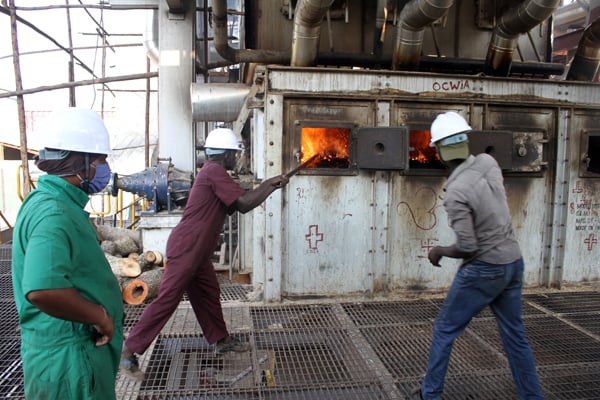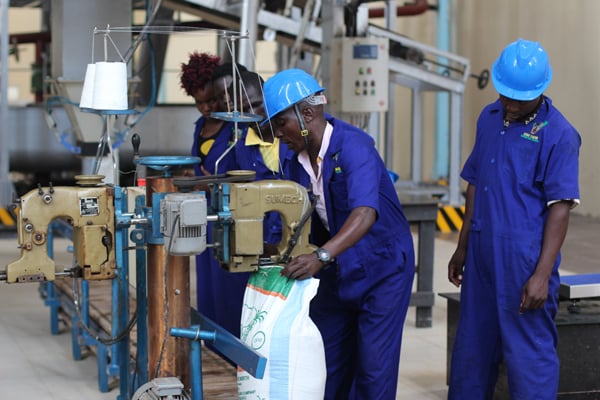Prime
Bittersweet wait for Atiak’s sugar

The Minister for Trade, Industry and Cooperatives, Mr Francis Mwebesa (right), and the chief executive officer of Atiak Sugar Factory, Dr Amina Hersi Moghe, during a tour of the factory in Amuru District on August 11. PHOTO | DAVID LUBOWA
What you need to know:
- Here, within the heart of a region known for its resilience and untamed beauty, lies a collection of factory equipment, now at rest yet brimming with latent energy. Like sentinels of progress, these dormant machines stand in quiet anticipation, their potential magnified by the surrounding tranquillity.
In the vast expanse of northern Uganda’s landscape, where the horizon seems to stretch endlessly, a scene of both promise and patience unfolds. Amid the undulating plains and beneath the open sky, an industrial tableau awaits its cue to come to life.
Here, within the heart of a region known for its resilience and untamed beauty, lies a collection of factory equipment, now at rest yet brimming with latent energy. Like sentinels of progress, these dormant machines stand in quiet anticipation, their potential magnified by the surrounding tranquillity.
At the heart of Atiak Sugar Factory, a symphony of innovation and industry, an unusual hush has fallen over the once bustling floor. Rows of intricate machinery, briefly vibrant with motion and purpose, now stand frozen in time, their gears and components waiting patiently for the touch of skilled hands to awaken them from their slumber. The air is pregnant with anticipation, as if the very atmosphere holds its breath, longing for the rhythmic dance of production to resume.
In this moment of stillness, the factory’s dormant equipment tells a story of both pause and potential, a canvas upon which the narrative of creation and productivity awaits its next brushstroke.
The factory jointly owned by Horyal Investment Holding Company Ltd and the government has invested heavily, but the plague that bedevils the entire sugar industry in the country quickly caught up with it.
Not an outlier
In March 2022, Atiak Sugar Factory in Amuru District temporarily shut down sugar production over inadequate cane supply. The factory commenced production of brown sugar for both domestic consumption and export in 2020, and was meant to get cane from both a nearby plantation and out-growers in Amuru and Lamwo districts.
Since the closure, the management of the facility with capacity to crush 1,650 tonnes of cane per day and about 60,000 metric tonnes of cane annually has been working to get the factory running again. The failure to generate cane has, however, kept the machinery silent.
Atiak Sugar Factory’s case is not unique, although the factory has had to completely halt operations. Uganda Sugar Manufacturer’s Association chairperson Jim Kabeho told Saturday Monitor that all sugar companies in the country are working at “half and below capacity” due to an acute shortage of cane.
“You have machines and employees to produce at 100 percent but you cannot. We are operating in losses. Government is not making money through taxes and there is no sugar for export,” he revealed.
New dams
In the midst of the factory’s temporary quiet, a dynamic transformation is underway across the expansive plantation. The construction of four robust dams is reshaping the landscape, promising a consistent source of irrigation that will counter the challenges of the dry season.
These dams are poised to revolutionise production by providing essential water supply to the cane fields. In doing so, they will guarantee a steady and uninterrupted yield even when nature’s conditions would otherwise pose obstacles. As the factory equipment patiently awaits its moment to roar to life, these dams stand as vital guardians of year-round productivity, ensuring that the fields remain lush and fruitful, regardless of the weather’s whims.
“Because of the delay, we have started to bring the project closer so that we can restart the factory. We are doing irrigation. Instead of us waiting for the cane to grow within 16 months, we want to shorten the time to 12 months. Even when it’s dry and there is no rain, the cane will be irrigated in the farms. We shall not wait for the rains,” Amina Hersi Moghe, the chief executive officer of Horyal Investments Holding Company Ltd, says
Atiak woes
Although the factory was projected to shut down for a short time pending the production of more cane, the current projections point to 2025 when it is likely to resume. Persistent government procurement delays have cast a shadow over the ambitious plan for large-scale cane cultivation.
The much-needed equipment, essential for transforming the fertile expanse into productive fields, has faced hurdles in its journey to the plantation. While contractors have managed to deliver machinery designed for harvesting, these valuable tools now sit dormant within the factory’s warehouses, awaiting the opportunity to fulfil their purpose. However, the vital components for clearing the land and initiating cultivation remain in a state of anticipation, stuck in transit.
“The contract took long and when the contractors were given their contracts they have brought machines which are supposed to be … it’s like when you are building, they have given you tiles but not the steel for building the foundation. We are still stuck. We could be planting, but we are still waiting for machines that would help us do the land preparation,” Ms Hersi says.
Delivery of inputs on-site required the growing of cane to commence at the factory was expected to be completed early this year, according to Patrick Birungi, the executive director of the Uganda Development Corporation (UDC), but to-date, they are yet to arrive.
The process of growing cane, which entails, among other things, land preparation, planting, cultivation and weed control, would follow but this, too, is yet to start, which has pushed the re-opening to tentatively 2025.
“This delay of machinery is being taken care of by trying to restart this factory again in the shortest period of time even if it means at a lower capacity but as the machinery comes. In fact, there is also a need of making a bigger factory or even putting more money in the factory as part of the comprehensive plan,” Mr Francis Mwebesa, the Trade minister, said during a tour of the facility, adding, “I have seen value for money and in fact I am seeing more need for money for this project in the long run. I am highly impressed. The work that is going on here is much more than what people are saying that there is no work going on at Atiak Sugar.”
What next
Several legislators have previously raised concerns about whether there is value for money in the investment that the government has made in the Atiak Sugar project.
Mr Francis Mwebesa, the Trade minister, says the investment is in line with the ruling National Resistance Movement (NRM) party manifesto and the National Development Plan, which place the sugar industry as a strategic investment. He argues that Ugandans stand to reap benefits from the global market.
“If you look at the figures of money coming out but you don’t come to see the real work, you will complain. What is a lot of money compared to the work that has been done here?” he notes.




